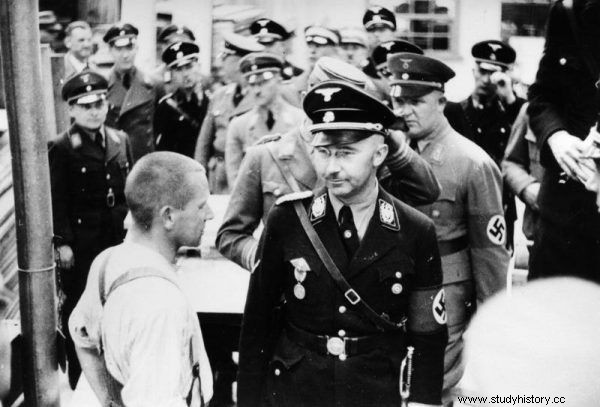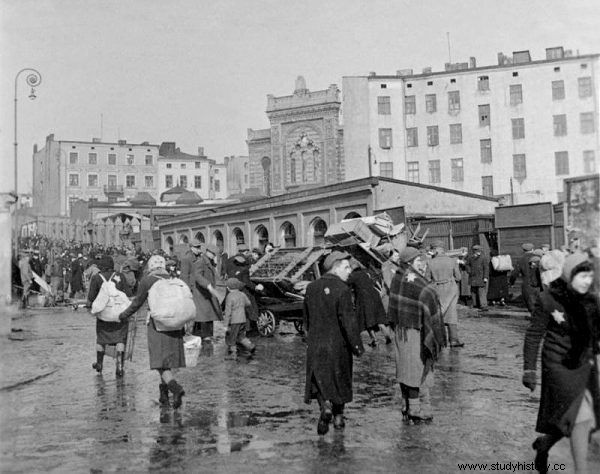There was no escape from the Łódź ghetto. No wonder then that it is within its borders that the Polen-Jugendverwahrlager der Sicherheitspolizei in Litzmannstadt (a preventive camp for young Poles of the Security Police in Łódź) was established. Let no one be fooled by the name that suggests "containment" activities of this "institution". The facility on Przemysłowa was a Nazi labor camp for children.
November 28, 1941 was a normal day for Heinrich Himmler. The start of planning the construction of a new camp in Łódź - this time for Polish children - was associated with the need to stay far from home and family, as well as an additional amount of work. However, these inconveniences would have to be nothing for him in view of the possibility of implementing the idea of racial selection, getting rid of the source of moral threat to little Germans and the promise of creating an ideal Aryan nation.
The camp was opened on December 11, 1942. Two weeks later, in a letter to his loved ones, Himmler wrote:
There is a lot of work to do, but I don't mind; will be a very hard year and will be the most demanding of all of us.
Attached is a late Christmas package, coffee from the Führer, a photo of the local Hegewald shelter in East Prussia, a package from Zippers for Dolls, a book and a letter from Gauleiter Hofer, marzipan, flour and sugar from the Koch gauleiter.
Little Auschwitz
The first transport of children arrived at the camp on the day it was opened. And although officially it was a place intended only for boys, girls also ended up here from the very beginning. As we read in the book by Jolanta Sowińska-Gogacz and Błażej Torański, Mały Oświęcim. Children's camp in Łódź ”:
The first number was given to Zdzisio Włoszczyński, the second number was given to Halinka Szturma, the third number was given to Miecio Wlazło ...

Lodz "little Oświęcim" was to help Himmler in creating an ideal Aryan society.
In accordance with the top-down regulations, children aged 8 to 16 were to be imprisoned in the facility at Przemysłowa Street. However, it quickly turned out that the lower limit was apparent and was primarily intended to protect the "center" against controls led by the Red Cross. Even infants taken from their mothers were locked there.
"From now on I am no longer a child"
After arriving at the camp, the children underwent a procedure similar to that used in Oświęcim. Only the tattooing of little hands was omitted - instead the inmates had numbers hung around their necks. As Jolanta Sowińska-Gogacz and Błażej Torański write:"Number, flash, dactyloscopy, uniform, hut, bunk bed". This is how Tadeusz Raźniewski remembered his first moments in the facility, who described them in the book "I want to live":
I get denim clothes, shirt, long johns, forage hat, slippers, old shabby coat, blanket, tin bowl, spoon and pot. You can see that all of this has already been used. (…) Sechshundertvierundzwanzig. At the request of the German, I hang the number around my neck. From now on, I am no longer a child.
Life in the camp was hard work. The boys were involved, among other things, in making straw shoes, tank mats, weaving baskets, producing straps for gas masks and leather parts for backpacks. They were also given tasks beyond their strength in the garden. The girls were herded to sew, clean and help in the kitchen.

The above text is based on the latest book by Jolanta Sowińska-Gogacz and Błażej Torański
“Mały Oświęcim. Children's camp in Łódź ', which has just been released by the Prószyński Media
The most difficult job for everyone was rolling the ground, which is far beyond the capabilities of even the most healthy and well-fed child. And yet the little prisoners in the camp went hungry, neglected, often sick and cold. Their day most often boiled down to a sequence of events, the mere mention of which sounds almost like a salvo from a machine gun:
A scream. Work. Cry. Beating. Kick. Scream. Blood. Trumpet. Appeal. Whip. Mummy! Detention. Foul-smelling slush instead of soup. Fever. Insomnia. Alle Achtung! Hell with no way out, no end .
Hunger, fear, confusion
One of the basic principles used by the overseers was to keep prisoners completely confused. As a result, the young prisoners could never expect what awaited them. Living in constant fear and stress, the constantly hungry children reacted instinctively. And in order to disturb these instincts as well, they went so far as to create chaos.
For example, one day a guard would appear in the barracks and shouting, asking which of the children had lice. When some of the little ones raised their hands out of sheer terror, they were rewarded with a hunk of bread. A few days later, the situation repeated itself, but this time those who confessed to the pests were severely punished. Having lice was forbidden in the camp.
However, this was only one of the many ways in which children were tortured in Polen-Jugendverwahrlager der Sicherheitspolizei in Litzmannstadt. "People think hunger was the worst, but for me the worst was the cold because we didn't have any calories, we were constantly cold, weak" - recalled one of Jolanta Sowińska-Gogacz's interlocutors.
"He was carrying matches"
It didn't take much to get to the camp at Przemysłowa Street. And although various reasons for detention were given, all the children had one thing in common - they were Poles. The authors of the book "Mały Oświęcim" mention, inter alia, the following justifications: "the daughter of a Polish professor", "throwing bread into the ghetto", "disturbing the environment and having a negative impact on German children", "futility of further education", "had matches with him".

The camp for children was established within the boundaries of the Łódź ghetto.
The strategy of catching children into the camp was multi-faceted. Orphans were taken, which were abundant during the war, children begging for food and wandering around the streets - which was also easy, since the schools were closed and the society was widespread hunger.
The imprisonment of the toddlers was also sometimes to be a punishment for their parents, who were members of the resistance movement and underground organizations. There are cases where they put dog tags around their kids' necks so that in the event of captivity someone who finds them would know where to send them back.
Stolen Children
The children imprisoned in the camp at Przemysłowa Street had only one "way to save". If, after the inspection, they proved to be Aryan enough, intelligent and easy to arrange, they could be transported to a Germanization center nearby and in the future to hit the honorable ranks of the youth of the Reich.
Interestingly, the exploitation of the youngest was illegal even in the Third Reich. However - as it turns out - the ideology of creating a superhuman Aryan nation at all costs was not hindered by such mundane things as the law.

The above text is based on the latest book by Jolanta Sowińska-Gogacz and Błażej Torański
“Mały Oświęcim. Children's camp in Łódź ', which has just been released by the Prószyński Media
The camp at Przemysłowa Street was only a means to an end. Its task was to eliminate bad patterns for German youth, punish the resisting population and eliminate growing problems, while gaining material benefits. For the Nazis, Little Auschwitz was a kind of "roasting two birds with one stone".
The lives of the children imprisoned in the "center" resembled a horror movie. There was even no need for gas or crematoria. Disease, hunger and superhuman exertion killed the young prisoners. Some of the survivors remained silent for centuries and do not recall these events, others shared their drama with Jolanta Sowińska-Gogacz and Błaże Torański. You will learn about their stories in the book Mały Oświęcim. Children's camp in Łódź.
Source:
The text is based on the book by Jolanta Sowińska-Gogocz and Błażej Torański Mały Oświęcim. Children's camp in Łódź , which has just been released by the Prószyński Media publishing house.
